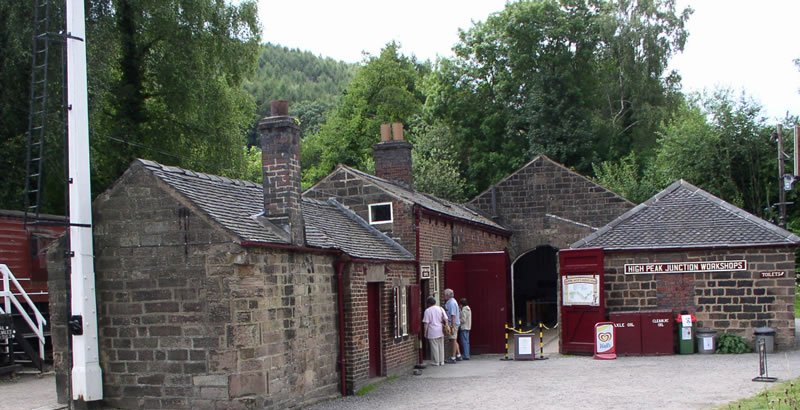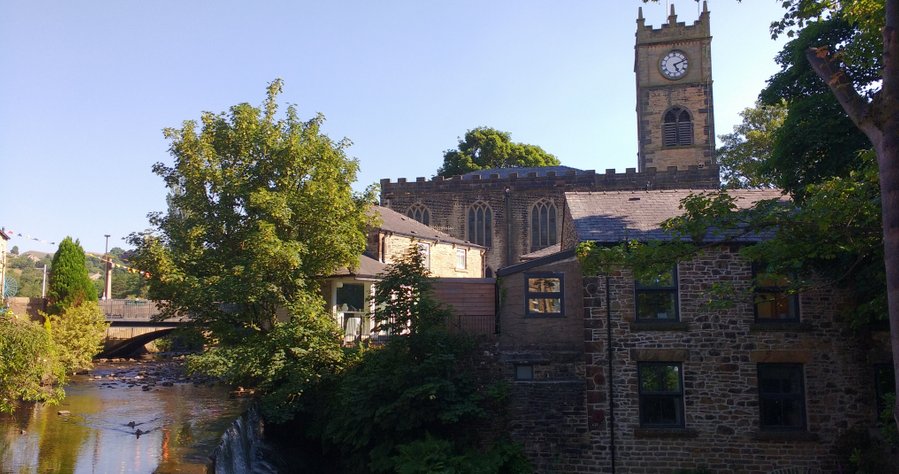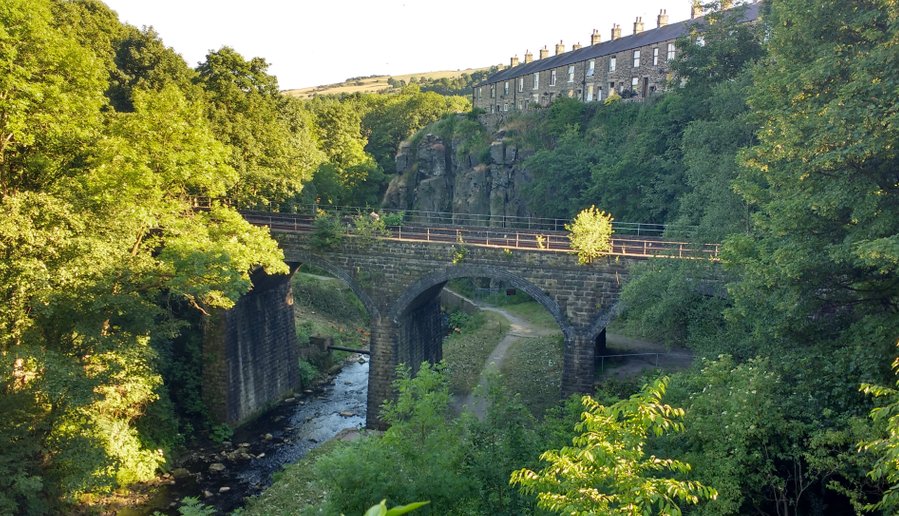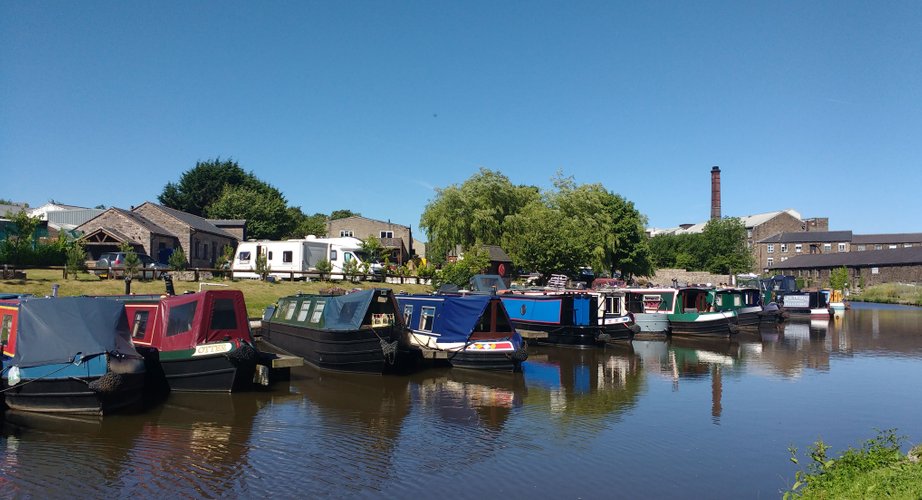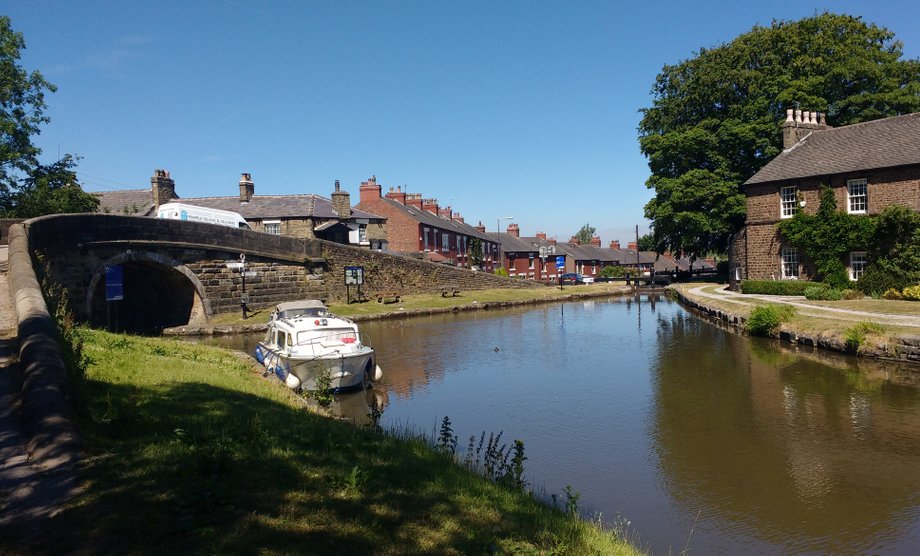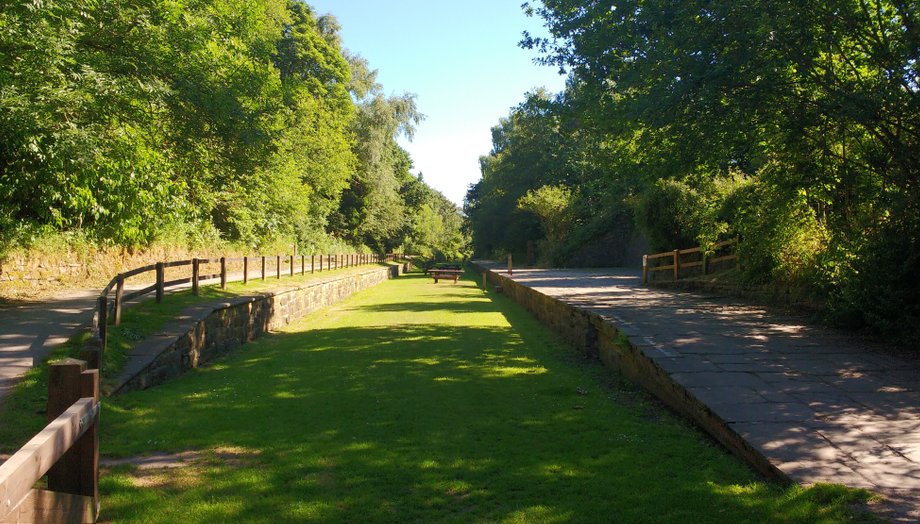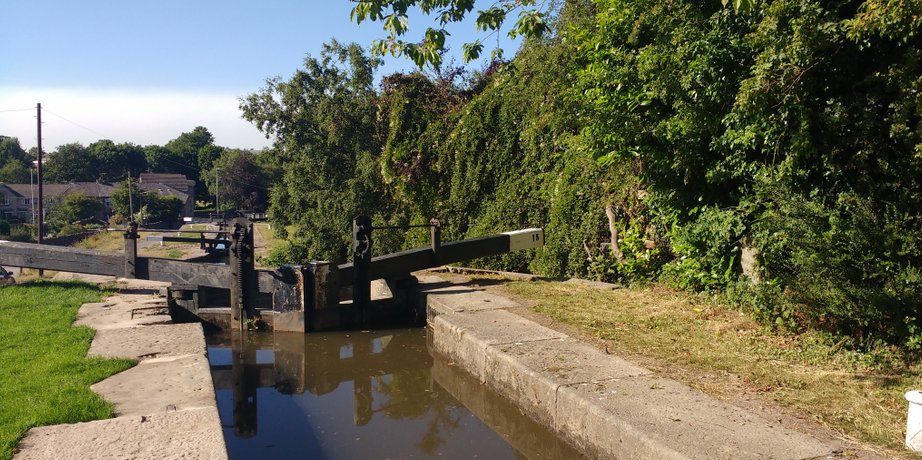Motorhometrips
with tips for cycling & hiking
The Peak District one national park, but two very different personalities.
In the northern part, the Dark Peak, is much wilder with open moorlands, heather glad and punctuated by peat bogs and outcrops of black granite . Much of the moorland is being restored to its original format. Here the dominant form of agriculture is sheep rearing. The underlying limestone is capped by impervious millstone grit and the result is that in winter the ground is always saturated, giving rise to the bogland and subsequent dark peat, in turn giving rise to its generic name.
The White Peak to the south has a much more gentle landscape, primarily because of the absence of the millstone grit cap, which has allowed the erosion of the underlying limestone. Here you will find sinkholes as rivers disappear underground, with limestone caves and lush green valleys. Agriculture is still dominated by cattle and sheep as the soils are very poor.
In both areas you will find evidence of past industrial activity to remind you that this was one of the original areas of the Industrial Revolution with its plentiful supply of water for propulsion and for industrial use. This is superbly illustrated by Cromford Mill, which was the first water powered cotton spinning factory developed by that pioneer of the Industrial Revolution, Richard Arkwright in 1771. Prior to that, spinning was a cottage industry practiced in the homes of the locals. The great news is that you can visit the factory and fully immerse yourself into the history of the Industrial Revolution, which changed the UK from a predominantly agrarian economy into an industrial superpower.
Further evidence of the area’s industrial past can be found in the canals and disused railways, many of which provide us with considerable cycling opportunities
Peak District -White Peak
The White Peak area of the Peak District centred around Ashbourne and Bakewell is one of our favourite haunts, as it not only offers stunning scenery but excellent cycling centred on the Tissington & High Peak Trails.
The Tissington trail runs from Ashbourne in the south to Parsley Hay, a distance of 13 miles, where it joins the High Peak trail, which runs from High Peak Junction near Cromford to Dowlow near Buxton, where it sadly terminates and therefore does not allow for an easy ride into Buxton.
The Tissington Trail was formerly the track of the Ashbourne to Buxton line. It was finally fully opened on August 4th 1899 and survived until 1967.
The signal box at Hartington, a few miles from the village which bears its name,between Ashbourne and Parsley Hay gives a potted history of the line
The loss of the railway line was, however, a gain for cyclists and pedestrians and in 1971 was opened as a greenway, being one of the first of its kind in the country. The surface has been greatly improved since its early days and is now a gravel track, which is easy for cycling and as with most railways without any significant inclines , the same can not be said, however, for the connecting High Peak Trail.
All 17 miles of the High Peak Trail follows the trackbed of one of the earliest railways in the country, the Cromford and High Peak Railway, which was completed in 1831 to carry minerals and goods between the Cromford Canal wharf at High Peak Junction and the Peak Forest Canal at Whaley Bridge.
The original plan was to look at a canal to connect the two systems but this was logistically impossible on the basis of costs, so the railway was the solution. It is an interesting line because of the steep inclines, as you come into High Peak Junction and trust me they are steep and they necessitated the use of static steam engines to raise the carriages from the canal.
Remnants of the winding gear needed to pull the engines up
It is great fun to cycle down the inclines, though in these days of health and safety, there are the numerous signs advising cyclists to dismount, possibly as you may end up ploughing into pedestrians on the way down ,which certainly will not be a problem when you tackle the ascent. This one of the reasons we visit off peak; as the two trails and in fact the whole area can get very busy in July and August and Bank Holidays.
Dovedale, which is one of the main attractions in the area can resemble Piccadily Circus in the rush hour. OK I exaggerate but you get the idea.
There is a brief respite in a level section between the two main inclines of Middleton and Sheep Pasture Incline where you can enjoy stunning views over Cromford.
At Middleton Top there is a fine example of one of these engines and housing(pictured below) used for the purpose, which is still brought into action on certain days, There is also a visitors centre and refreshments available here, but only at weekends.
As with the Tissington Trail, the lines were victims of the Beeching Closures but I must confess I can not see how the High Peak trail ever made any money,
If you make it down to High Peak junction , though making it down is not a problem, as it is the return which is the challenge, you will meet the Cromford canal.
High Peak Junction - photograph courtesy of Steve Brown
As with the Tissington Trail, the lines were victims of the Beeching Closures but I must confess I can not see how the High Peak trail
A short ride along the canal brings you to Cromford Mill, which was the first water-powered cotton spinning mill developed by Richard Arkwright in 1771 and is a superb example of our industrial heritage and you can easily spend half a day exploring our industrial past.
If you want to explore the mills then you would be best advised to look at a campsite nearer. There is a camping and caravanning certified site at New Harboro and Griffe Walk Farm, which is near Middleton Top with direct access to the High Peak Trail.
The nearest commercial site is Birchwood Farm, which is a short walk from High Peak junction and there is a bridle path to the High Peak Trail.
We based ourselves at Rivendale Caravan Park, which is open for the majority of the year and is sited in an old quarry. It has good heated shower facilities and is ideal for off peak camping, particularly as it will accept Camping Cheques.
The added advantage of Rivendale is that Dovedale is readily accessible from the site.
You simply go up to the Tissington Trail, turn left along the trail and take the first footpath on your right and at the end of this path turn left into Biggin Dale,
When it meets the river Dove you have the choice of turning left towards Dovedale or right along Wolfscote Dale to Hartington.
The walk along Wolfscote Dale is quieter and as equally beautiful as Dovedale and at the end it opens up as you enter Hartington. Offpeak, Hartington gives you the impression of one of those villages that time has forgotten with its duckpond and superb general store where they will make you a fresh sandwich, provide you with a hot drink which is best taken to the duckpond, where you can enjoy lunch overlooking the pond towards the garage, which looks like a relic from the 1930’s. It has a superb cheeseshop offering a staggering variety of cheeses .Alternatively there are a couple of pubs and other eateries.
You can easily cycle to Hartington though the descent along the minor road is steep but we prefer to walk along Wolfscote, which is an easy day walk, with lunch in the middle.
Dovedale is via MillDale with Polly’s for tea & snacks, though sadly it was closed when we visted.
At the other end at the National Trust carpark refreshments are also available but this was also closed as the carpark was being renovated, which was a blessing in disguise, as it limited the number of trippers.
The Dale can get extremely busy but if you walk early morning or late evening, most day trippers have either gone or not arrived. If it gets too much you can always return by the high road by turning right past the Isaak Newton Hotel (also closed when we visited so good job we had our lunch) then climbing over Bunster Hill before dropping down very steeply at Ilam Rocks to join the Dale again. The descent was made more tricky by the fact, that though we had glorious weather, it had followed one of the wettest winters on record and the path was extremely greasy.
A different perspective, as you take the high road.
The Tissington Trail is situated opposite the site and it is about 7 miles from Ashbourne, downhill on the way down and a gentle climb on the way back. There are refreshments available at the cycle centre at the end of the line, though it is better to go into Ashbourne to the little café at the corner of the square. Ashbourne is a pleasant market town but is somewhat marred by the heavy traffic that flows through it and the number of large lorries.
The Tissington Trail towards Ashbourne is not all level but nowhere near the inclines of the High Peak Trail
It is about 5 miles to Parsley Hay and the junction of the High Peak Trail. If you carry on for a short distance past the junction, there are refreshments available.
You then join the 15 mile section to High Peak Junction. The High Peak Trail is narrower in places than the Tissington Trail .
This embankment on the High Peak shows Victorian engineering at its finest.
You can return the same way or take two cycle ways back,the first via Carsington Water (refreshments available) and the second towards Biggin.Both are signposted from the High Peak Trail. They follow minor roads or by ways with busy junctions being by passed.
All the cycle rides are well signposted.
The Carsington Water route is the longest marginally but the more enjoyable, Both routes rejoin the Tissington Trail, the first at Tissington and the second just outside of Biggin.Both routes are predominately downhill with the only significant uphill section on the Carsington Water route, as you climb, after crossing the ford just outside of Bradbourne, before dropping down to the village of Tissington. Both routes are shorter than the return route using the High Peak Trail.
Ford at Brabington but you do not have to get your feet wet, which was a good job as the water levels were very high.
Alternative Campsites
Callow Top is a large commercial site with shop and bar etc and is located by road about ¾ mile form the Tissington Trail just outside of Ashbourne. We stayed here at Whitsun and though it was busy we were lucky to have a quiet pitch tucked into the corner though I had much sympathy frothe motor home pitched next to the children’s playground.
It is not a site that I would rush back to, and in any case it is not open when we want to visit the area, it is far too busy for our tastes though we had a pleasant stay here.
It did have the annoying habit of charging extra for showers. Imagine going to a hotel and being asked to put 50p in for a shower
Near Carsington there is an inexpensive site, Uppertown Farm Leisure but again not open when we wanted it.
Be warned,however,that if you want to cycle the High Peak Trail from here, it is a very steep climb. You would be better off cycling to Tissington and then doing it in reverse
The Motorhome and Caravan Club have a site at Carsington Water, which is a beautiful site and great location for the reservoir but it again is a steep climb to the Tissington.
he Dark Peak OS Map Explorer OL1
Two Camping and Caravan Club sites provide us with the cycling and walking opportunities in this area.
Hayfield
This is a superb site set in the Sett river valley, surrounded by hills and views of Kinder Scout.
A short walk along the river brings you to the very attractive village of Hayfield with its pubs, butcher and local stores and a short walk from the site is the Sportsman Inn, which does excellent food.
It is difficult now to envisage that this was once a thriving industrial area with several cotton mills, fabric printing and dyeing with calico printing particularly important. In fact the campsite is located on the site of the Kinder Printworks Mill and prior to that, during the 16th century, this area referred to as 'Cutler's Green was a major centre for the cutlery industry before Sheffield overtook it.
In 1868 the railway age arrived at Hayfield, connecting the village to Manchester. It is this railway, which closed in 1970 and now is the Sett Valley Trail which provides us with the artery to our cycle routes.
Sett ValleyTrail
You take the path from the campsite, the first short section of which you have to walk and then this opens up to the road, which takes you into the village. You go down to the church and then take the path, which crosses the by pass and leads you into a car park area, which is the site of the old station and the start of the trail.
The actual trail is quite short, about 2.5 miles but what it lacks in length it more than makes up for with some beautiful scenery. As you enter the town of New Mills, you cross one main road which is signposted the Pennine Bridal Way and then you meet another, which is adjacent to the River Goyt. You want to turn left in order to pick up the next stage of the cycle route, the Peak Forest Canal. Before you do, however, cross the road and continue to follow the Sett Valley Trail to reach Torr Top and the Millennium walkway. You will have to push your bike for part of this but it is worth it as it is spectacular, then retrace your steps, otherwise you will end up going through the town.
Peak Forest Canal
You have two ways of approaching this. Firstly you can cross the road and follow the Goyt Valley Way and this is to be recommended, as it is stunning and the first part is downhill. You then reach a farmhouse, where you turn right and then you take a path, where the last section involves quite a steep but short walk up to the canal.
The second choice is to turn right on the main road up to the Swizzles factory and before you cross the bridge over the canal, look for a road on your left which takes you to the canal. This is a more direct route but less scenic and the road can sometimes be busy and with heavy traffic.
Bugsworth Basin - turn left when you reach the canal towards the the terminus of the canal, Bugsworth Basin, which has been beautifully restored.
